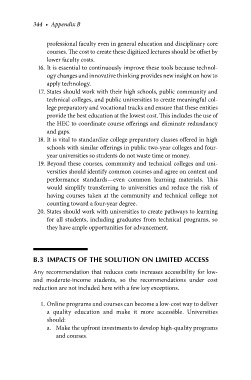Page 374 - Crisis in Higher Education
P. 374
344 • Appendix B
professional faculty even in general education and disciplinary core
courses. The cost to create these digitized lectures should be offset by
lower faculty costs.
16. It is essential to continuously improve these tools because technol-
ogy changes and innovative thinking provides new insight on how to
apply technology.
17. States should work with their high schools, public community and
technical colleges, and public universities to create meaningful col-
lege preparatory and vocational tracks and ensure that these entities
provide the best education at the lowest cost. This includes the use of
the HEC to coordinate course offerings and eliminate redundancy
and gaps.
18. It is vital to standardize college preparatory classes offered in high
schools with similar offerings in public two-year colleges and four-
year universities so students do not waste time or money.
19. Beyond these courses, community and technical colleges and uni-
versities should identify common courses and agree on content and
performance standards—even common learning materials. This
would simplify transferring to universities and reduce the risk of
having courses taken at the community and technical college not
counting toward a four-year degree.
20. States should work with universities to create pathways to learning
for all students, including graduates from technical programs, so
they have ample opportunities for advancement.
B.3 IMPACTS OF THE SOLUTION ON LIMITED ACCESS
Any recommendation that reduces costs increases accessibility for low-
and moderate-income students, so the recommendations under cost
reduction are not included here with a few key exceptions.
1. Online programs and courses can become a low-cost way to deliver
a quality education and make it more accessible. Universities
should:
a. Make the upfront investments to develop high-quality programs
and courses.

